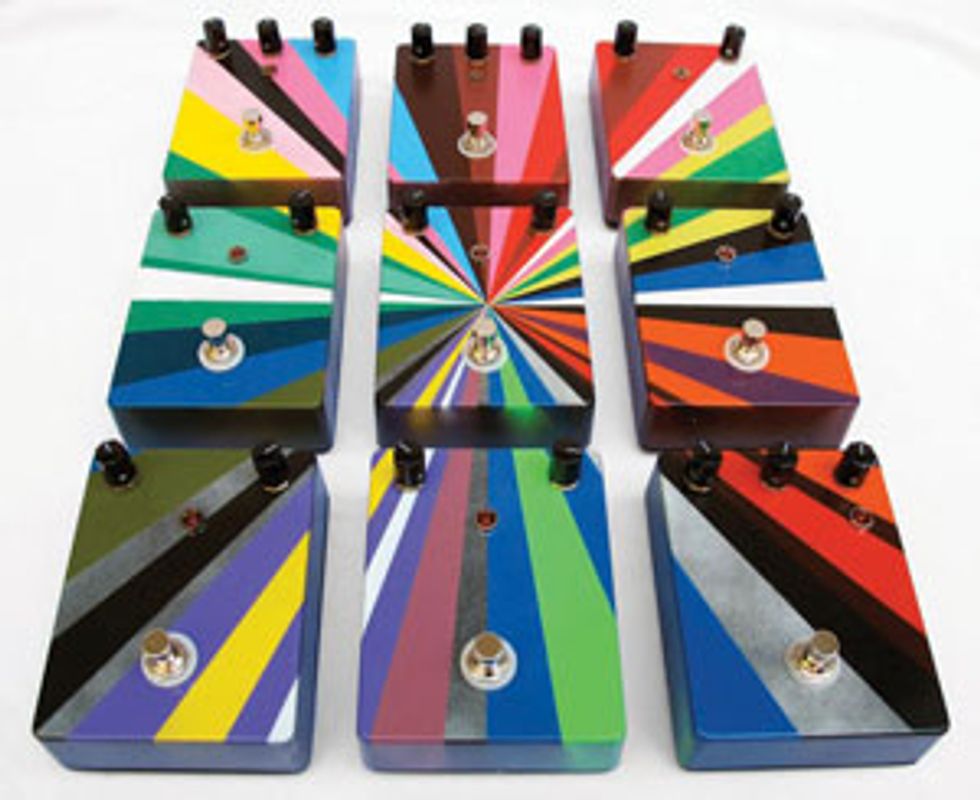 Matt W. Moore’s beautifully painted “pedal puzzle” provides a great
metaphor for the gear marketing game.
Matt W. Moore’s beautifully painted “pedal puzzle” provides a great
metaphor for the gear marketing game.In my previous column [“Mirror Industries,” November 2011], we examined the near mirror-image similarities between the musical gear and recording industries, and then posited that there are several key pieces to the marketing “puzzle” that are necessary to successfully launch a product in either market. If you’ve ever thought about creating your own pedals—or are just curious about what challenges a boutique builder faces—read on.
We left off with an imagined effect builder getting ready to market a new guitar overdrive pedal. Of course, it’s the most inspiring, dynamic, transparent, responsive pedal ever created. In other words, let’s assume the product in question is of high quality and meets some current need in the marketplace—regardless of whether this need is real or perceived. Here are some pieces to consider when putting together the marketing puzzle.
Reviews. One of the best ways to market a product is to have industry authorities recommend it. It used to be that if a band landed on the cover of Rolling Stone, then chances were they were really going somewhere. Similarly, getting a positive review in a guitar magazine was the fastest way to build a buzz on a new pedal and grab some sales. With the advent of new technologies, including streaming media and such new communication tools as user forums, blog sites, and social media, it’s not quite so simple anymore. Even if a magazine raves about a product, chances are potential buyers are going to hit YouTube to see a video demo or scour message boards to gather more info.
Some people feel print mags skew the editorial to favor advertisers. Well, just keep in mind that this can also hold true for YouTube vids and information exchange sites. A fair number of product-demo videos made by “unbiased” third parties are anything but, and there is usually something being exchanged for the work—at the very least, the pedal being demoed. Also, some retail entities with strong online followings will create and post video content in exchange for better price breaks on the product in question. I’m not saying gear demonstrators shouldn’t be compensated for their work, but it’s a pretty safe bet that in this situation the demonstration will be at least slightly slanted towards the positive.
Keep in mind that online stats can be manipulated, and many record companies have teams of people that are constantly blogging, tweeting, or otherwise working to create a perceived buzz on a band. Likewise, YouTube “video view bots” can be used to spike the views on a video, and some companies aren’t above making smear videos of competing products and posting them under anonymous third-party accounts.
So to summarize: Getting positive press on your product (or music, for that matter) is a great way to build a buzz and start the sales rolling in. As a consumer, however, you need to take everything you see with that proverbial grain of salt.
Endorsement. I could probably fill an entire issue of PG writing about artist endorsements and some of the wacky experiences I’ve had with them. Suffice to say that artist endorsements are a key marketing strategy for most major gear brands, and they’re probably here to stay.
Having a popular or well respected artist using your latest pedal can be a great way to garner some quick attention. This could be equated to a band grabbing the opening slot on a major tour. For example, both Mötley Crüe and Metallica were catapulted to super-stardom after opening for the legendary Ozzy Osbourne.
Just keep in mind that it’s a manufacturer’s responsibility to spread the word about who’s using its pedals, so if you’re going to take this route make sure you’ve got a plan in place to get this info out to the masses. Print ads are sexy but expensive, and they require a lot of impressions to grab people’s attention. As pedal distributors, we’ve had good success posting artist video interviews to YouTube. They’re also a lot of fun to make and we get to go to a free show to boot!
Price Point. One place where the recording and MI industries don’t parallel one another is in regards to price point. Obviously, all records cost pretty much the same, but effect pedals can have an extremely wide price variation—from $19.95 up into the hundreds (if not thousands) of dollars.
Lower price points may have a wider appeal, but you should consider what segment of the market you are trying to appeal to. Some users may have the perception that a lower-priced pedal can’t be as high quality as a more expensive one. Price with your target market in mind, and don’t forget to build in a solid profit margin for the retailers who sell your pedals— they need to make money, too.
One last parallel I’ll draw between the recording and musical instrument worlds is how larger companies watch smaller ones to get their market research. In the recording industry, when a new genre starts to make some noise on a grassroots level, the larger players in the industry take notice and try to get in on the action. Similarly, Guitar Center recently took a stab at high-end effects with their “boutique pedal expansion” project.
Just remember that the used CD bins are filled with one-hit wonders. To build a successful brand you need a solid foundation, and that can take years of hard work to establish. Good luck!
 Kevin Bolembach
iKevin Bolembach
is the President and
founder of Godlyke, Inc.
- the U.S.distributor for
many well-know boutique
effect brands
Including Maxon,
Guyatone, EMMA and Providence.
Kevin Bolembach
iKevin Bolembach
is the President and
founder of Godlyke, Inc.
- the U.S.distributor for
many well-know boutique
effect brands
Including Maxon,
Guyatone, EMMA and Providence.





![Rig Rundown: Russian Circles’ Mike Sullivan [2025]](https://www.premierguitar.com/media-library/youtube.jpg?id=62303631&width=1245&height=700&quality=70&coordinates=0%2C0%2C0%2C0)


























